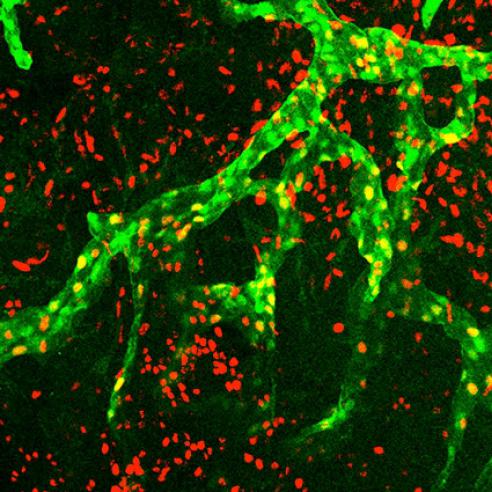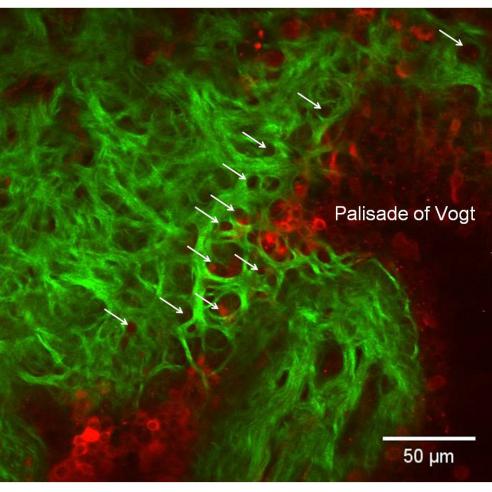RPB researchers are working to improve the management of corneal disease.
Corneal Disease

This is a wavefront aberration map showing irregularities in the cornea from a patient with keratoconus, a degenerative disease that causes thinning and bulging of the cornea.
Customized correction methods, including special contact lenses, are being developed and tested to correct these irregularities, including those that remain following corneal transplant surgery. http://www.cvs.rochester.edu/yoonlab/
The cornea is the clear front layer of the eye that serves as a protective barrier and the first point of entry for light into the eye. Its health is crucial to sight. The cornea bends light, which passes through an opening in the colorful iris, called the pupil, and then through the lens, which further focuses the light onto the retina. There, light is translated by photoreceptor cells into visual information that is conveyed to the brain via the optic nerve, where it is interpreted as vision.
Corneal damage is a leading cause of blindness world wide, but especially in less developed countries. Corneal clouding or scarring can result in glared or blurred vision.
Click one of the video selections to view.
The causes of corneal damage include injuries to the outermost layer of the cornea, damage or scars from other eye surgeries, infections, hereditary corneal defects, and inflammation from chronic dry eye. Symptoms of corneal damage and dry eye can include pain, tearing, light sensitivity, blurred vision, and a feeling that something is in the eye. Treatments include lubricating eye drops and ointments, patches for protection from irritation, antibiotics, anti-inflammatory eye drops, and special contact lenses to bandage the cornea.
Corneal transplants are often needed when vision cannot be corrected with other treatments.
Researchers funded by Research to Prevent Blindness (RPB) are working to better understand the corneal wound healing process in order to develop new strategies for transplantation and other treatments for corneal damage.
More than 40,000 corneal transplants are performed each year in the U.S., making it the most common type of transplant. Although most transplants are initially successful, many fail due to rejection of the transplanted cornea by the body's immune system. The reasons for rejection have been poorly understood, until recently.
Related News: Cornea

Understanding Corneal Injuries in Dry Eyes
An RPB grantee makes a key discovery involving genes that are essential for eye health.

Research to Prevent Blindness Marks $400 Million in Funding to Advance Eye Disease Research
RPB funds a new round of researchers and hits a milestone in supporting vision-related breakthroughs.

Possible Solution to Corneal Transplant Rejection
Study reveals a way to inhibit excessive growth of lymphatic vessels which contribute to organ transplant rejection, cancer metastasis, lymphatic obstruction, diabetes and hypertension.

New Eye Structures Discovered
Novel structures found in the cornea of the human eye using second harmonic generation imaging microscopy.

Artificial Cornea: New Option for the Treatment of Corneal Conditions
Over the years, research has led to developments that have improved the success of corneal transplantation, but there is still a group of people for whom traditional cornea transplants usually fail. That's...
Subscribe
Get our email updates filled with the latest news from our researchers about preventing vision loss, treating eye disease and even restoring sight. Unsubscribe at any time. Under our privacy policy, we'll never share your contact information with a third party.
| General Info | Grants | News & Resources |



